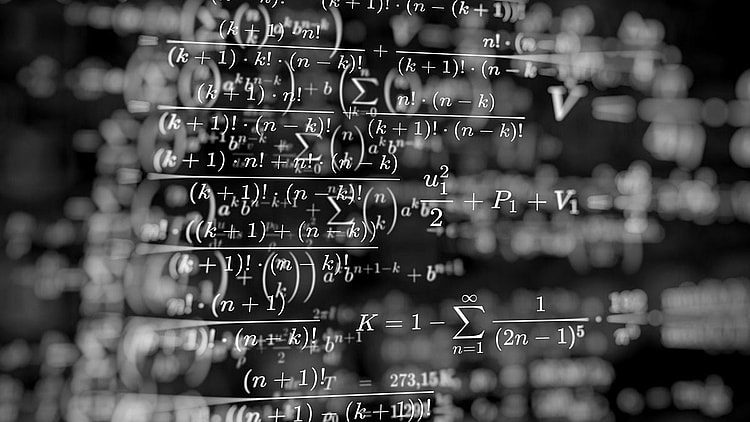
For many of us, math was incredibly hard in school. There was something about it that didn’t click with us unlike so many of our peers. But for others, math truly comes easy.
It’s interesting to know that so many formulas we use were invented to make our lives a bit easier or to explain phenomena in the world. Several formulas even take years, even decades, to complete and solve. But what about the hardest math problems that are still left unsolved?
There are several of these problems in the world that are still unsolved, and there are even monetary rewards that you can get if you solve them. If you want to get confused, or maybe try your hand at these unsolved math problems, check out this list.
RELATED: Most Expensive Monitors You Can Use for Work From Home
Hardest Math Problems Still Unsolved
15. Hadamard Matrix
Named after French mathematician Jacques Hadamard, the Hadamard Matrix is a square matrix whose entries are either -1 or +1 and whose rows are mutually orthogonal.
In geometric terms, each pair of rows in the matrix represents two perpendicular vectors while in combinatorial terms, it means that each pair of rows has matching entries in exactly half of their column and mismatched entries in the remaining columns.
14. Yan-Mills Existence and Mass Gap
As mentioned, several problems are so difficult that several mathematicians reward those who can solve them. These are some of the hardest math problems in the world that are unsolved, and only one out of the seven have been solved.
The other six are still waiting for proof. The Yan-Mills Existence and Mass Gap is one of those problems with a $1 million reward on it. This problem is a non-abelian quantum field theory and asks the general problem of determining the presence of a spectral gap in a system that is known to be undecidable, which is proved to be impossible to construct an algorithm that leads to a yes-or-no answer.
13. P Versus NP
Another of the seven unsolved math problems in the Millennium Prize Problems selected by the Clay Mathematics Institute is the P Versus NP, a problem in theoretical computer science.
It seeks to figure out whether every problem whose solution can be quickly verified can also be quickly solved. An answer to the P versus NP question would determine whether the problems that can be verified in polynomial time can also be solved in polynomial time.
If it turns out that this is not the case (or P ≠ NP), which is widely believed, it would mean that there are problems in NP that are harder to compute than to verify. This idea was first introduced in 1971 by Stephen Cook in his seminal paper.
12. Hodge Conjecture
Yet another one of the famous Millennium Prize Problems through Clay Mathematics Institute that will hand out a large sum of cash to those who can solve it, the Hodge Conjecture is one of the hardest math problems in algebraic geometry and complex geometry.
The conjecture asserts that the basic topological information like the number of holes in certain geometric spaces, and complex algebraic varieties, can be understood by studying the possible nice shapes sitting inside those spaces, which look like zero sets of polynomial equations.
This was formulated by William Vallance Douglas Hodge, a Scottish mathematician, between 1930 and 1940 to enrich the description of de Rham cohomology to include extra structure.
11. Navier-Stokes Equations
Another unsolved math problem that is on the list of the Millennium Prize Problems is Navier-Stokes Existence and Smoothness, also known as simply Navier-Stokes Equations. These mathematical problems are a system of partial differential equations that describe the motion of a fluid in space.
While the solutions to these equations are used in many practical applications, the theoretical understanding of the solutions is incomplete. These solutions often include turbulence, which remains one of the greatest unsolved problems in physics, despite its immense importance in science and engineering.
To put it simply, it asks whether we can always find a solution that describes the behavior of a fluid continuously and smoothly without any abrupt changes or singularities. Claude-Louis Navier contributed his findings in 1822 and George Gabriel Stokes’ added to it from 1842 to 1850, and have since been developed over several decades.
10. Birch and Swinnerton-Dyer Conjecture
One of the hardest unsolved math problems is the Birch-Swinnerton-Dyer Conjecture. It’s so difficult that this is one of the seven Millennium Prize Problems listed by Clay Mathematics Institute that offers a $1 million reward if you can solve it.
The problem describes the set of rational solutions to equations defining an elliptic curve, which is a smooth, projective, algebraic curve of genus one, on which there is a specified point O.
The problem seeks to establish a connection between the arithmetic properties of an elliptic curve and the behavior of a function called the L-function. The main idea is that if we understand this connection, we can figure out how many rational points exist on these elliptic curves.
The problem in the number theory was named after mathematicians Bryan John Birch and Peter Swinnerton-Dyer who developed it in the 1960s with the help of machine computation. As of 2023, only special cases of the conjecture have been proven.
9. Euler-Brick Problem
One of the hardest math problems focuses on rectangular cuboids whose edges and face diagonals all have integer lengths. The problem seeks to find solutions to a system of Diophantine equations, which typically are a polynomial equation, usually in two or more unknowns, where only the integral solutions are required.
This concept comes from Leonhard Euler, a Swiss mathematician who significantly contributed to number theory and geometry during the 18th century. While he found parametric solutions to the problem, these solutions did not cover all cases, therefore several parts of this problem are still left unsolved.
8. Lehmer’s Totient Problem
Lehmer’s Totient Problem is related to Euler’s Totient Function and is one of the hardest unsolved math problems in the world. The problem asks whether there can be a composite number ‘n’ with a specific property related to the Euler Totient function.
Euler’s function, denoted as φ(n) calculates the count of positive integers less than ‘n’ that are coprime, which means they have no common factors other than one. To make it easy for those who are getting a headache, Lehmer’s problem seeks to see if there are any non-prime numbers for a certain mathematical function (φ(n)) that results in a specific value of n-1
7. The Large Cardinal Project
German mathematician Georg Cantor figured out that infinity can come in different sizes, and some infinite sets have more elements than others:
Mathematicians keep discovering larger and larger numbers or sizes, known as Large Cardinals. So the process goes that a definition for a cardinal is arrived at until someone proves that another cardinal is bigger than all other known cardinals. Then, depending on their proof, that becomes the new largest cardinal.
Throughout the last century, the known large cardinals have steadily been pushed forward. While the top of the large cardinal hierarchy appears to be in sight, many questions remain open about how big this final large cardinal number will be.
6. Unknotting Problem
The simplest version of the Unknotting Problem has been solved today, but the full version remains unsolved. The basis of this problem emerges from the math topic Knot Theory:
The existing algorithm can unknot the knots of any complexity, but when the knots start getting more complicated, the algorithms start to take an impossibly long time to solve.
So what remains to be seen is if someone can develop an algorithm that can unknot any number of knots in what is known as polynomial time, this will finally solve the Unknotting Problem once and for all.
(However, at the same time, someone could even prove that this problem is unsolvable).
5. Kissing Number Problem
In the top five hardest math problems is the Kissing Number Problem. The Kissing Number Problem specifies the following – when there are numerous spheres packed in an area, each sphere is said to have a kissing number, which is the number of other how many spheres it is touching.
For example, if you are touching six neighboring spheres, then the kissing number is six.
A packed bunch of spheres will have an average kissing number to help describe the situation in terms of mathematics. However, it is when the problem crosses three dimensions or large numbers that the Kissing Problems remain unsolved.
CHECK OUT: Most Dangerous Places in the World: From Hell’s Door To Snake Island
4. Riemann Hypothesis
One of the most important open problems in math is the Riemann Hypothesis. There is even a million-dollar reward for its solution:
(That’s right, this is one of those million-dollar math problems you’ve no doubt heard about).
The Riemann Hypothesis focuses on all non-trivial zeros of the Riemann zeta function in real part 1/2.
In terms of complex numbers, this means that the function has a specific behavior along a vertical line, and the hypothesis states that this behavior will continue along this line infinitely.
The understanding of prime numbers has developed significantly in the last 160 years, but there has been no solution to the Riemann Hypothesis yet.
3. Twin Prime Conjecture
The Twin Prime Conjecture is one of the most famous unsolved problems in math. It is one of the many number theory problems, involving prime numbers. When two primes have a difference of two, they are called twin primes.
For example, 11 and 13 are twin primes, as are 599 and 601.
Number Theory states that there are infinite prime numbers, so it should hold that there are infinitely many twin primes. Accordingly, the Twin Prime Conjecture predicts that there are infinite twin primes.
While mathematicians have made progress on the problem in the last decade, they are still far from solving it. Making it one of the hardest math problems in the world.
2. Goldbach’s Conjecture
Goldbach’s Conjecture remains one of the hardest math problems to date. Simply put, Goldbach’s Conjecture states that every even number that is greater than two is the sum of two primes. While computers have checked the Conjecture for several numbers, the proof is still needed for all natural numbers.
Many feel that Goldbach’s Conjecture is an understatement for very large numbers. Nevertheless, this problem has continued to puzzle mathematicians for a long time.
1. The Collatz Conjecture
This 82-year-old math question continues to confuse mathematicians all over the world. In September 2019, Terence Tao made some breakthroughs on this problem, however, it remains unsolved.
The Collatz Conjecture is about the function f(n), which takes into account even numbers and cuts them in half. At the same time, the odd numbers get tripled and added to 1. The Conjecture holds that this is true for all natural numbers.
The Conjecture is derived from the math discipline known as Dynamical Systems, meaning the study of situations that change over time in some semi-predictable way.
Which Millennium Prize Problem Was Solved?
Only 1 out of the 7 Millennium Prize Problems have been solved after all this time, which means one lucky nerd gained an extra $1 million to their bank account (or did they?). But out of all of them, with all being listed above, was the one that was solved?
The Poincaré conjecture was the lucky one and is in the field of geometric topology. The theorem about the characterization of the 3-sphere, which is the hypersphere that bounds the unit ball in four-dimensional space. This conjecture was introduced by Henri Poincaré in 1904. The theorem concerns spaces that locally look like ordinary three-dimensional spaces but are finite in extent.
Who Solved It?
Richard S. Hamilton’s program of using the Ricci flow eventually laid the groundwork of the proof, and he was recognized with the Shaw Prize and the Leroy P. Steele Prize for Seminal Contribution to Research.
But it was Grigori Perelman who was able to modify and complete Hamilton’s program and eventually was seen as the true solver. However, when offered the monetary reward, he denied it and said that Hamilton’s contribution was equal to his.



